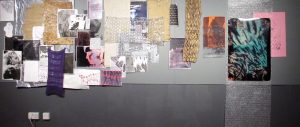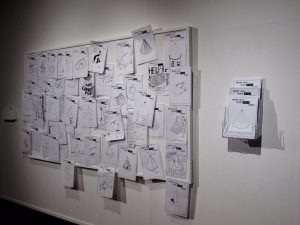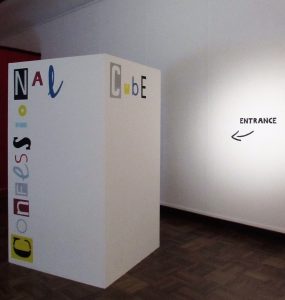MFA Art, Society and Publics
This year’s MFA students have turned the area around the Cooper Gallery into one of the most involved exhibition experiences I’ve ever seen.
 Josh Wilson’s Project ASaP is not only an excellent pun on the title of the course but involved me ‘asap’ in the gallery. I followed Wilson’s set of instructions to look through the rails and pick something of my choosing to add to the ever-changing public board. The retail arrangement of materials allows the participant to take their time and think about what they want to add to the wall, and how they wish to arrange it. The overall look of the board, although documented at the end of the day, is not the sole purpose of Project ASaP; it is about the fun of taking part and not being shy to do so.
Josh Wilson’s Project ASaP is not only an excellent pun on the title of the course but involved me ‘asap’ in the gallery. I followed Wilson’s set of instructions to look through the rails and pick something of my choosing to add to the ever-changing public board. The retail arrangement of materials allows the participant to take their time and think about what they want to add to the wall, and how they wish to arrange it. The overall look of the board, although documented at the end of the day, is not the sole purpose of Project ASaP; it is about the fun of taking part and not being shy to do so.
TakeTime by Lauren Gardiner in the upper level of the Cooper Gallery is a quiet space for the audience to take respite in. In the  space is a white cotton tent with warm lighting inside for participants to use, a public board with activity sheets to fill in and badges to take away. These sheets take me back to the ones my local library used to give out when I was younger. The artist is keen for TakeTime to move beyond the gallery and to make the art work in other spaces so that it can continue to promote the opportunity for self-care.
space is a white cotton tent with warm lighting inside for participants to use, a public board with activity sheets to fill in and badges to take away. These sheets take me back to the ones my local library used to give out when I was younger. The artist is keen for TakeTime to move beyond the gallery and to make the art work in other spaces so that it can continue to promote the opportunity for self-care.
Near TakeTime is Jen Lightbody’s The Confessional Cube, a white cube sculpture for confessions. Initially, I was wary of the sculpture. There was something unsettling about the  white exterior, which had ransom-note font used for the title. This contrasts with the traditional Catholic wooden confession booth that allows for secrecy. I thought it was a trick and that, perhaps I would have been secretly filmed. However, once inside the participant is not compelled to say or do anything, it is a completely private space and is honest in its intention of allowing the participant to relieve themselves of any personal burdens. Like TakeTime, Lightbody offers badges in return for participation, one of the badges read ‘I’ll strive to Do Right’ and stood out as a good reminder of what humans should aim to live by.
white exterior, which had ransom-note font used for the title. This contrasts with the traditional Catholic wooden confession booth that allows for secrecy. I thought it was a trick and that, perhaps I would have been secretly filmed. However, once inside the participant is not compelled to say or do anything, it is a completely private space and is honest in its intention of allowing the participant to relieve themselves of any personal burdens. Like TakeTime, Lightbody offers badges in return for participation, one of the badges read ‘I’ll strive to Do Right’ and stood out as a good reminder of what humans should aim to live by.
Returning to the entrance of the Cooper Gallery, Charis & I displays four video performance pieces titled An Act of Love. The pantomime costume draws the participant in with childlike curiosity, however, one is met with a critique of systems of oppression in societies and a call instead to love one another. Her skilful acting as Erasmus’ Folly – the Goddess of Foolishness – is demanding. In An Act of Love, Charis’ installation space has an ongoing participatory event ‘A circle for conversation’. Please, take part and let Charis make you tea or coffee, as this event, I think, captures one of the most magical capabilities of art. On Saturday, without realising it, I spent more than two hours in the circle talking with Charis and another woman who had come to visit the show. I won’t say what was discussed as it is a safe space. However, I will say that after this woman shared her personal story and experiences, then left, something came over me: I started to cry. This response was something I couldn’t control and shows how art has the power to transform spaces and people.
Art can be, and do, more when it pursues active engagement for the audience to take part in. These students get that, and I left feeling more at one with myself. This is the final year for the MFA Art, Society and Publics course and their focus is on promoting a healthy relationship between artworks and audiences that will be sorely missed from future Masters’ shows.
Jodie Williamson

Leave a Reply